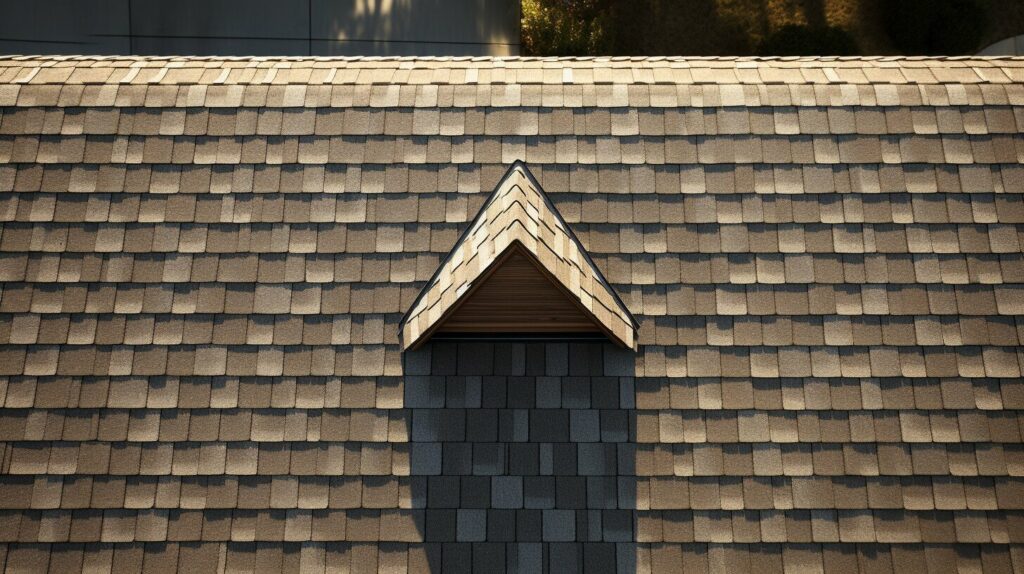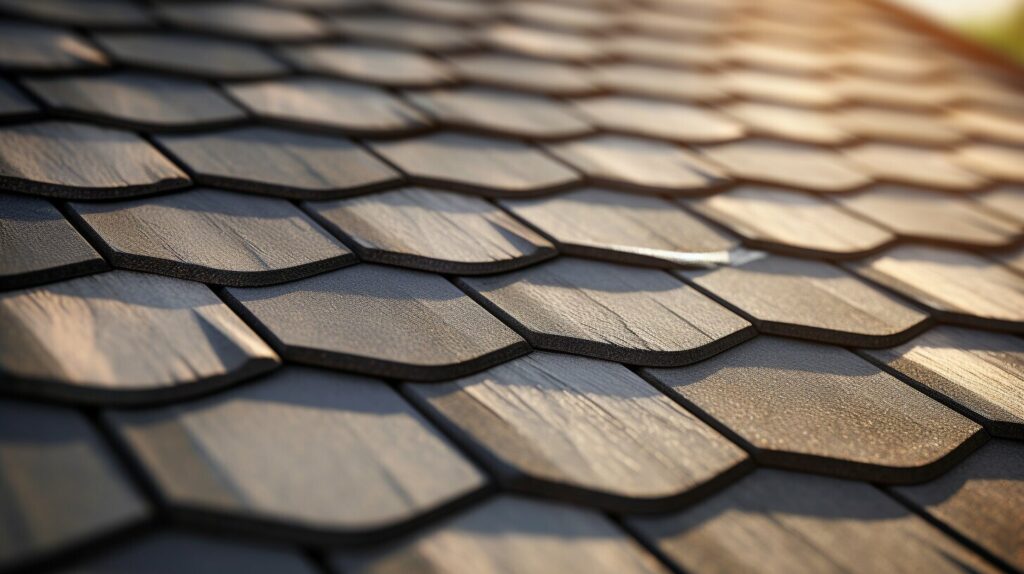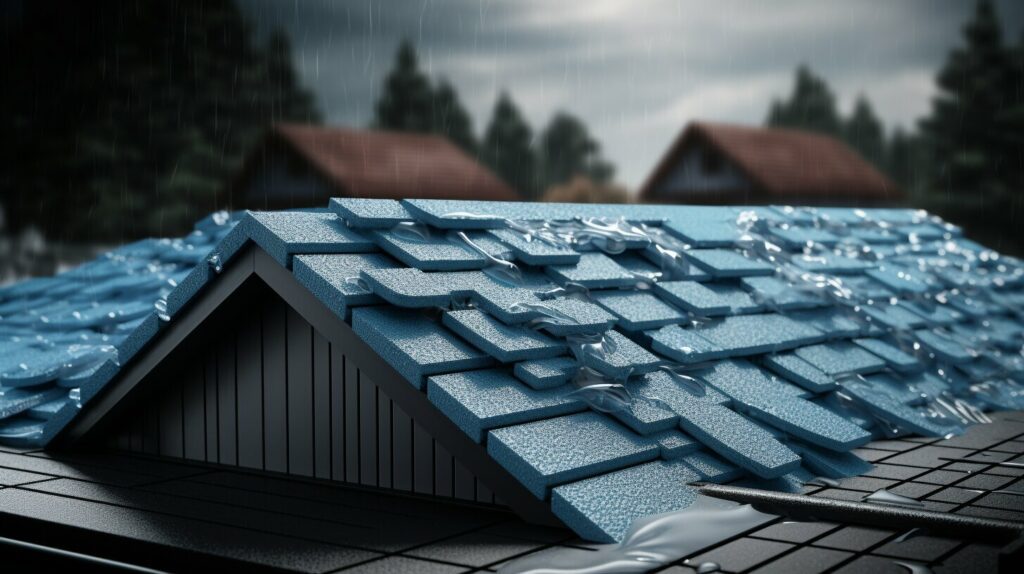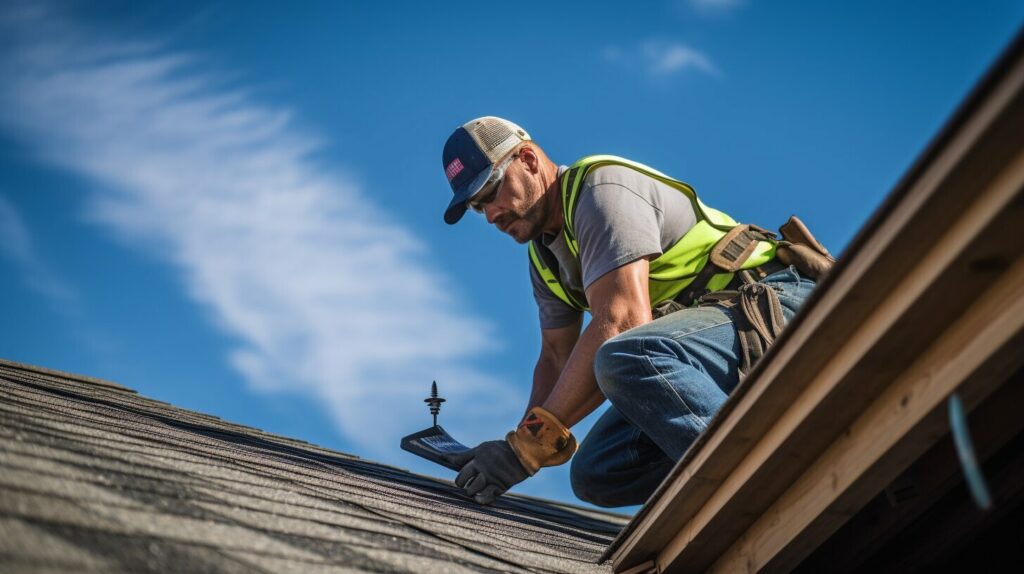When it comes to roofing, shingle overlap is a critical factor in ensuring your roof is waterproof and durable. Proper shingle overlap techniques can help protect your home from water damage, wind uplift, and other external elements. But how far should shingles overlap for the best results?
In this comprehensive guide, we will explore the ideal distance for achieving a tight seal and preventing water infiltration. We’ll cover best practices for determining the shingle overlap width, recommended overlap for roofing shingles, achieving proper shingle overlapping, and much more. Whether you’re a homeowner or a professional roofer, understanding the correct shingle overlap techniques is crucial to ensure the longevity and effectiveness of your roofing system.
Key Takeaways:
- Proper shingle overlap is crucial for protecting your roof from water damage, wind uplift, and other external elements.
- The recommended shingle overlap distance varies depending on the type of shingles and the slope of your roof.
- Achieving the correct shingle overlap technique ensures a tight seal and prevents water infiltration.
- Maintenance and inspections play a crucial role in maintaining the integrity of your shingle overlap.
- Hiring a professional roofer has its advantages, especially when it comes to achieving proper shingle overlap.
Importance of Proper Shingle Overlap
When it comes to your roofing system, proper shingle overlap is crucial for protecting your home from water damage, wind uplift, and other external elements. By following shingle overlap best practices, you can ensure a durable and long-lasting roof that delivers the protection you need. Achieving the correct shingle overlap distance is essential for the effectiveness of your roofing system.
Proper shingle overlap offers numerous benefits, such as enhanced waterproofing, improved wind resistance, and increased durability. The ideal shingle overlap length should be determined by the type of shingles and the slope of your roof. Therefore, it is crucial to follow the correct shingle overlapping technique to improve your roof’s performance and protect your home.
When achieving proper shingle overlapping, the correct shingle overlapping technique and distance are critical. The technique will differ based on the type of shingle and the roof’s pitch and slope. Following the correct technique, such as starting at the eave edge and staggering the seams, will ensure a tight seal and prevent water infiltration. Furthermore, achieving proper shingle overlapping requires having the right knowledge, tools, and safety equipment.

Whether you are installing new shingles or replacing old ones, it is crucial to maintain proper shingle overlap distance. This will help you achieve an optimal shingle overlapping technique and avoid common mistakes such as insufficient overlap or excessive overlap. Proper shingle overlap distance will also help prevent damage from wind uplift, moisture, and temperature changes. Therefore, it is essential to determine the shingle overlap width based on weather conditions, the local building code, and the shingle manufacturer’s recommendation.
By following the proper shingle overlap best practices and achieving the correct shingle overlapping technique, you can increase the lifespan of your roof and protect your home from potential damage. So, make sure to consult a professional roofer or follow the recommended guidelines when installing or repairing your shingles to ensure a watertight and durable roofing system.
Determining the Shingle Overlap Width
Calculating the correct shingle overlap distance is crucial for achieving a durable and watertight roof. To determine the appropriate shingle overlap width, you need to consider several factors, such as the type of shingles and the slope of your roof.
The recommended shingle overlap for residential asphalt shingles is typically around 1.5 to 2 inches, while wood shingles require a wider overlap of 2 to 2.5 inches. For metal shingles, the recommended overlap can range from 1 to 2 inches, depending on the manufacturer’s instructions.
| Shingle Type | Overlap Width (inches) |
|---|---|
| Asphalt | 1.5-2 |
| Wood | 2-2.5 |
| Metal | 1-2 |
Additionally, the slope of your roof also plays a role in determining the correct shingle overlap width. Steeper roofs require wider shingle overlaps to prevent water from seeping in, while flatter roofs can have narrower overlaps.
Calculating the shingle overlap distance may seem daunting, but it can be easily determined by measuring the exposed length of a single shingle and multiplying it by the recommended overlap width. For example, if the exposed length of your shingle is 10 inches and the recommended overlap width is 2 inches, the shingle overlap distance would be 12 inches (10 + 2).
Pro Tip: When installing shingles on a roof with a steep slope, use shorter shingle lengths to achieve a wider overlap and avoid sliding.
By considering the type of shingles, the slope of your roof, and the recommended overlap distance, you can determine the appropriate shingle overlap width for your roofing system.

Recommended Overlap for Roofing Shingles
When it comes to achieving optimal shingle overlap, different types of roofing materials have varying recommended overlap measurements. To ensure the ideal shingle overlap length for your specific roofing material, consider the following guidelines:
| Roofing Material | Ideal Shingle Overlap Length |
|---|---|
| Asphalt Shingles | 4-6 inches |
| Wood Shingles | 1.5-2 inches |
| Metal Shingles | 2 inches |
Keep in mind that these are general guidelines, and it’s always best to consult your manufacturer’s instructions for specific recommendations. Following the recommended overlap for roofing shingles can help prevent water infiltration and ensure a tight seal.
Additionally, the pitch of your roof can also impact the recommended shingle overlap. For steeper roofs, a wider overlap may be necessary to provide adequate protection against wind uplift and water penetration. Consult a professional roofer if you are unsure about the appropriate shingle overlap width for your specific roofing needs.

In summary, achieving the ideal shingle overlap length is crucial for maintaining a durable and watertight roof. By following the recommended guidelines for your specific roofing material and considering the pitch of your roof, you can ensure the proper shingle overlap distance. Proper shingle overlap can help prevent costly water damage and increase the longevity of your roofing system.
Achieving Proper Shingle Overlapping Technique
When it comes to achieving proper shingle overlap, there are a few essential tips you need to keep in mind to ensure your roof is watertight and durable.
Tip #1: Always start at the bottom of the roof and work your way up. This ensures that each piece of shingle overlaps the one below it, preventing water from seeping in.
Tip #2: Use the recommended overlap distance for your shingle type. This varies depending on the material and the slope of your roof, so be sure to consult the manufacturer’s recommendations or a professional roofer.
Tip #3: Watch out for misalignment. Shingles should be laid in a straight line, with the overlap distance maintained consistently throughout the roof.

Tip #4: Use roofing cement or other approved adhesives to secure the overlap and prevent wind uplift.
Tip #5: Avoid excessive overlap, which can create a bulging effect and decrease the shingle’s lifespan.
By following these tips, you can achieve the correct shingle overlap and enhance the durability and waterproofing of your roofing system.
Factors Affecting Shingle Overlap
Several factors can impact the shingle overlap distance and determine the appropriate width for achieving a durable and watertight roofing system. Understanding these factors is crucial to ensure the longevity and effectiveness of your roof.
- Climate: The climate in your area plays a significant role in determining the shingle overlap distance. In areas with high rainfall, for instance, a wider overlap is recommended to prevent water from seeping through the gaps between the shingles.
- Pitch of the roof: The slope of your roof also affects the shingle overlap distance. Generally, the steeper the roof, the shorter the overlap should be to prevent wind uplift and maintain stability.
- Local building codes: Local building codes may prescribe specific guidelines for shingle overlap distance, which must be adhered to. Failing to comply with these regulations may lead to legal and safety issues.
By taking into account these factors and following the recommended guidelines, you can achieve the optimal shingle overlap distance for your roofing system, ensuring maximum protection and durability against external elements.

Common Mistakes to Avoid
Ensuring proper shingle overlap is critical for a durable and watertight roof. However, some common mistakes can compromise the effectiveness of your shingle overlap. Here are some mistakes to avoid:
- Insufficient overlap: Not providing enough overlap between shingles can lead to water infiltration and damage to underlying roof structures. Make sure to follow the recommended overlap guidelines for the type of shingle used.
- Excessive overlap: Providing too much overlap can create unnecessary weight on your roof and may cause it to sag over time. Additionally, excessive overlap can create a breeding ground for mold and mildew, leading to premature aging of your shingles.
- Misalignment: Misaligned shingles can create gaps in the overlap, which in turn can lead to water seepage and damage. It is essential to maintain proper alignment throughout the shingle installation process.
By avoiding these common mistakes, you can achieve a strong and durable shingle overlap that will protect your roof for years to come.

Maintenance and Inspections
Regular maintenance and inspections are crucial to ensuring the longevity and effectiveness of your shingle overlap. Over time, natural wear and tear, weather conditions, and other external factors can compromise the shingle overlap’s integrity, leading to leaks and other issues.
To avoid costly repairs and premature replacement, it’s recommended to schedule regular maintenance and inspections for your roofing system. This involves checking for any signs of damage or wear, such as cracks, missing or broken shingles, and debris buildup.
It’s also important to address any issues promptly to prevent them from worsening. Small leaks or damage can quickly escalate into larger problems if left untreated, leading to further damage to your roof and potential water damage to your home’s interior.
During inspections, a professional roofer can assess the condition of your shingle overlap and make recommendations for repairs or replacements as needed. They can also provide guidance on proper maintenance techniques, such as cleaning gutters and downspouts and removing debris from the roof’s surface.
| Shingle Overlap Maintenance Tips |
|---|
| 1. Clear debris from the roof surface regularly to prevent buildup and damage to the shingles. |
| 2. Trim overhanging branches to minimize the risk of falling debris and potential damage to the shingle overlap. |
| 3. Clean gutters and downspouts to prevent water buildup and potential water damage to the roof and interior. |
| 4. Watch for signs of damage or wear, such as cracks or missing shingles, and address them promptly to prevent further damage. |
| 5. Schedule regular inspections with a professional roofer to assess the shingle overlap’s condition and identify any potential issues. |
By following these maintenance and inspection tips, you can help ensure the effectiveness and longevity of your shingle overlap and roofing system as a whole.

Benefits of Proper Shingle Overlap
Proper shingle overlap offers numerous benefits that go beyond just protecting your roof from the elements. By achieving the correct shingle overlap distance, you can enhance the performance and longevity of your roofing system, resulting in:
- Enhanced waterproofing: Shingle overlap creates a watertight seal that prevents water from penetrating your roof and causing damage to the underlying structure. By achieving the recommended shingle overlap distance, you can ensure optimal water resistance and reduce the risk of leaks and water infiltration.
- Improved wind resistance: Shingle overlap is also important for protecting your roof against wind uplift and damage caused by strong winds. By achieving the appropriate shingle overlap width, you can improve the wind resistance of your roofing system and prevent shingle blow-off.
- Increased durability: Proper shingle overlap helps to increase the lifespan of your roofing system by reducing the wear and tear caused by weather, foot traffic, and other external factors. With the appropriate shingle overlap technique and installation, you can ensure that your roof remains strong and durable for many years to come.
- Potential energy savings: Shingle overlap can also impact the energy efficiency of your home by reducing heat loss and gain through the roof. By achieving the proper shingle overlap technique and distance, you can improve the insulation of your roofing system and potentially lower your heating and cooling costs.
These benefits highlight the importance of achieving the correct shingle overlap for your roofing system. By following the recommended guidelines, you can ensure a durable, watertight, and energy-efficient roof.

Hiring a Professional Roofer for Shingle Overlap
While DIY may seem like a cost-effective option for shingle overlap installation, hiring a professional roofer can save you time, money, and headaches in the long run. An experienced roofer has the expertise and equipment necessary to achieve the correct shingle overlap distance and technique, ensuring a watertight and long-lasting roofing system.
Moreover, a professional roofer can spot and address potential issues that an untrained eye may miss, such as underlying damage to the roof structure or improper ventilation. They can also provide insights and recommendations on selecting the best shingles and materials for your specific climate and environment.
When hiring a professional roofer for shingle overlap, it’s important to do your research and choose a reputable and licensed contractor. Look for reviews and references from previous customers, and ask for a written estimate and contract outlining the scope of the work, timeline, and pricing.
Remember, investing in a professional roofer for shingle overlap can ultimately save you time, money, and stress, while ensuring the longevity and effectiveness of your roofing system.

Conclusion
Congratulations! You have now gained a comprehensive understanding of shingle overlap and the best practices for achieving the ideal distance for your roofing system. Remember, proper shingle overlap is crucial for protecting your roof from water damage, wind uplift, and other external elements.
By following the guidelines for determining shingle overlap width, calculating the recommended overlap for roofing shingles, and achieving proper shingle overlapping technique, you can ensure a tight seal and prevent water infiltration.
Be aware of the factors that can affect shingle overlap, such as climate, pitch of the roof, and local building codes, and avoid common mistakes, including insufficient overlap and misalignment.
Regular maintenance and inspections of your shingle overlap can help identify potential issues and prevent future problems, leading to enhanced waterproofing, improved wind resistance, increased durability, and potential energy savings.
If you’re unsure about shingle overlap installation or repairs, it’s always best to hire a professional roofer for optimal results. Thank you for reading, and may your roofing system be strong, durable, and watertight for years to come.
FAQ
Q: How far should shingles overlap?
A: Shingles should overlap by approximately 4-6 inches to ensure proper water shedding and protection against wind uplift.
Q: What are the best practices for shingle overlap?
A: The best practices for shingle overlap include following the manufacturer’s guidelines, considering the pitch of the roof, and using appropriate fasteners.
Q: How do I determine the shingle overlap width?
A: The shingle overlap width can be determined by calculating the desired overlap distance based on the slope of your roof and the type of shingles being used.
Q: What is the recommended overlap for roofing shingles?
A: The recommended overlap for roofing shingles can vary depending on the type of shingles. In general, asphalt shingles should have a 4-6 inch overlap, while wood and metal shingles may require a larger overlap.
Q: How can I achieve proper shingle overlapping technique?
A: Proper shingle overlapping technique can be achieved by following step-by-step instructions, ensuring a tight seal, and avoiding common mistakes such as insufficient or excessive overlap.
Q: What factors can affect shingle overlap?
A: Several factors can affect shingle overlap, including the climate, pitch of the roof, and local building codes. It is important to consider these factors when determining the recommended shingle overlap distance.
Q: What are some common mistakes to avoid in shingle overlap?
A: Common mistakes to avoid in shingle overlap include insufficient overlap, excessive overlap, and misalignment. Following proper installation guidelines and taking the time to ensure accurate overlap can help avoid these errors.
Q: How should I maintain and inspect shingle overlap?
A: Regular maintenance and inspections are key to maintaining the integrity of your shingle overlap. Inspecting for damage or misalignment and making necessary repairs or adjustments can help prevent future issues.
Q: What are the benefits of proper shingle overlap?
A: Proper shingle overlap offers benefits such as enhanced waterproofing, improved wind resistance, increased durability, and potential energy savings. It is an important factor in ensuring the longevity and effectiveness of your roof.
Q: Should I hire a professional roofer for shingle overlap?
A: While DIY installation is an option, hiring a professional roofer can offer advantages, especially when it comes to achieving proper shingle overlap. They have the expertise and knowledge to ensure a watertight and durable roofing system.